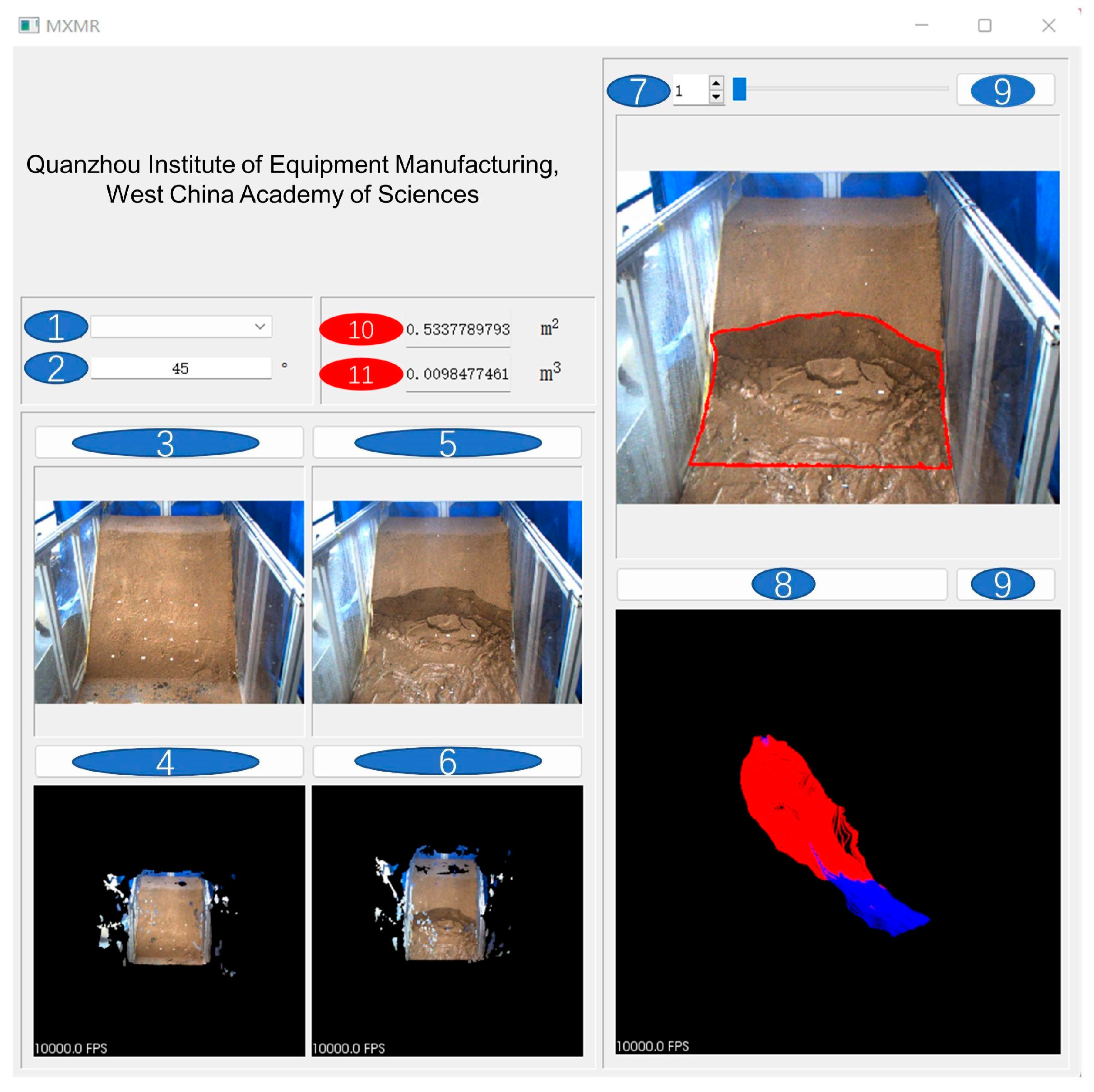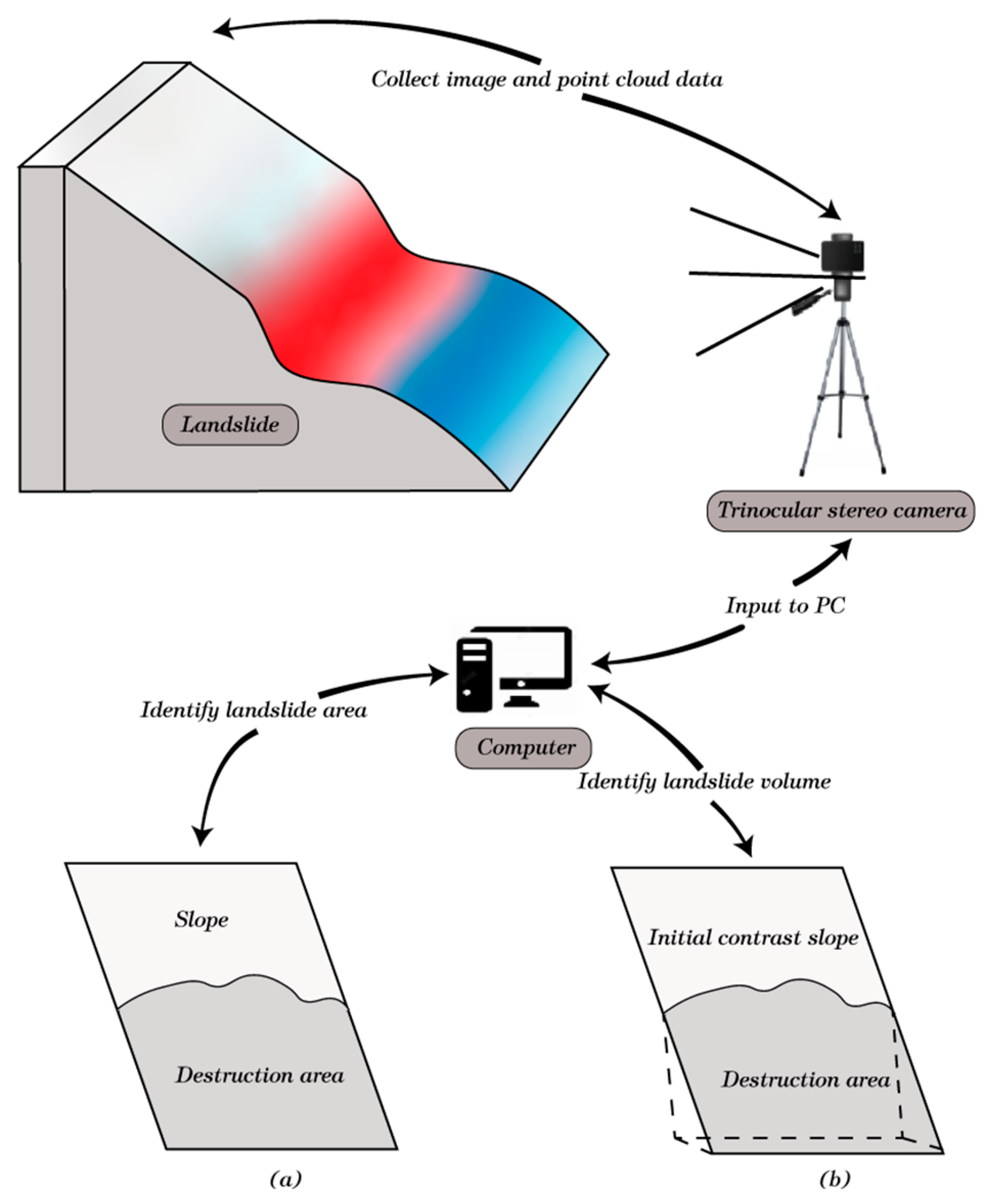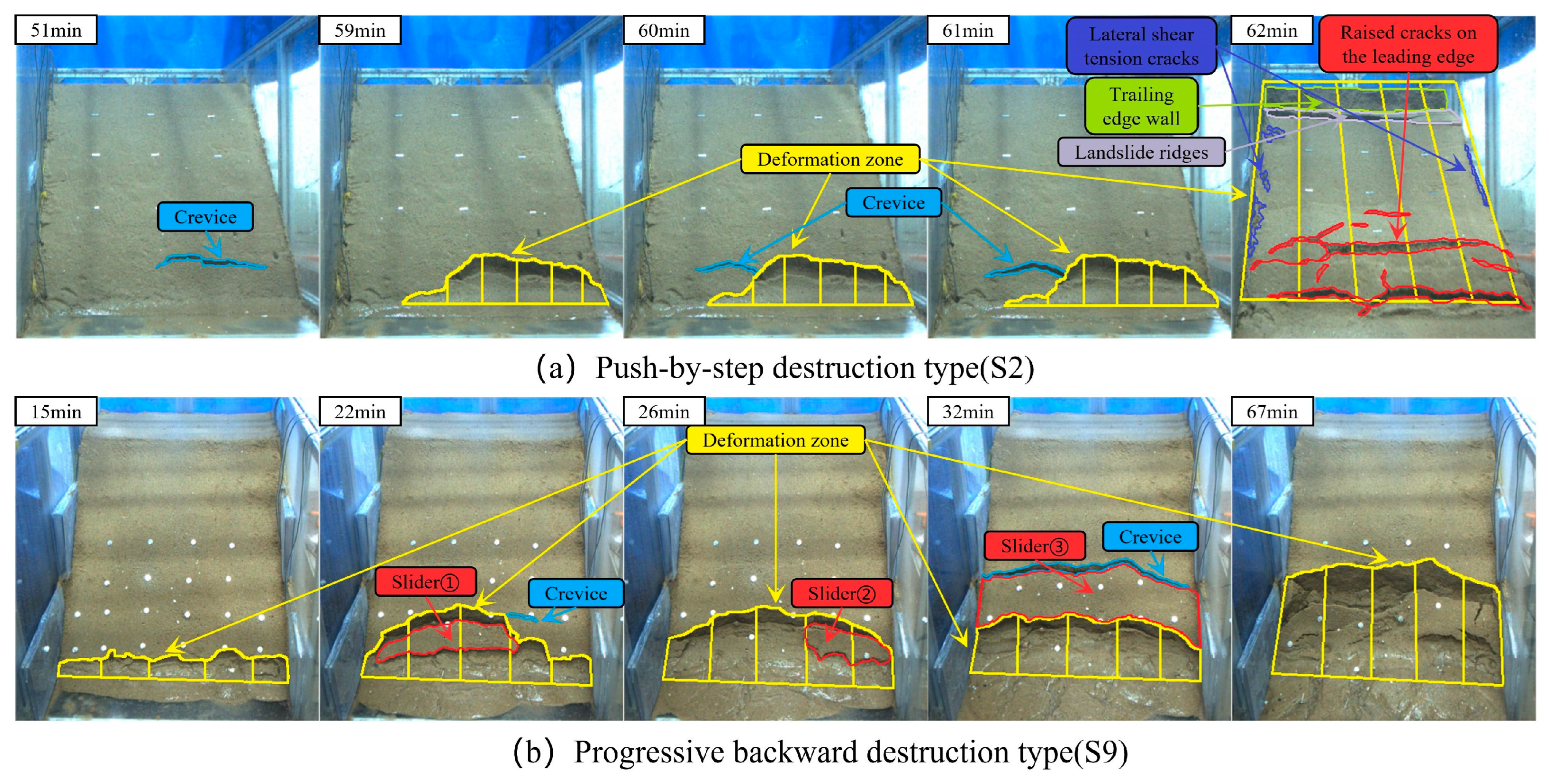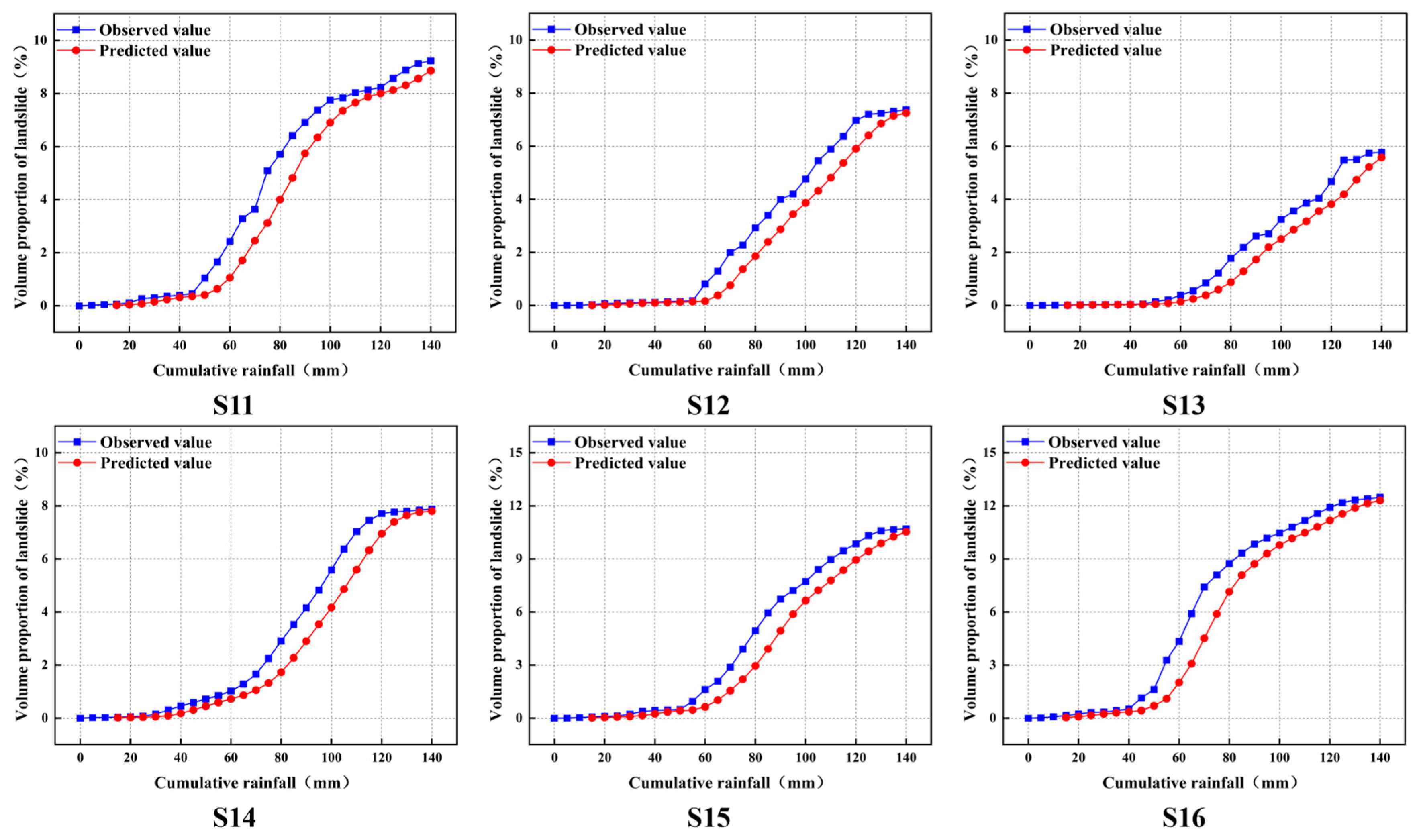Prediction of Landslide Deformation Region Based on the Improved S-Growth Curve Model
Abstract
:1. Introduction
2. Physics Experiments
2.1. Experimental System
2.2. Experimental Program
3. Quantitative Analysis of Landslide Deformation Area
3.1. Quantitative Analysis Methods
3.2. Experimental Results and Analysis
4. Landslide Volume Prediction Model
4.1. S-Growth Curve
4.2. S-Growth Curve Fitting
4.3. Predictive Model Development
5. Discussions
5.1. Evolutionary Pattern of Deformation Area
5.2. Comparison of the Improved S-Curve-Based Model with the Time Series Analysis Moving-Average Model
5.3. Highlights of this Study and Outlook
6. Conclusions
- (1)
- Under continuous rainfall conditions, a certain amount of rainwater will first converge at the foot of the slope, causing the first damage to occur at the foot of the slope and then triggering larger-scale damage. In this process, the slope damage degree shows the trend of the S-growth curve, and the slope damage mode also shows two types of damage, namely, nudge damage and progressive backward push.
- (2)
- The intensity of rainfall and landslide volume are negatively correlated. The larger the slope angle is, the faster the slope destabilization damage is, but the landslide volume value is the largest for the slope angle of 45°. The presence of a slope roof platform will accelerate the damage of the slope and increase the degree of damage. The soil compaction degree of the base layer is higher, and a slope without confining pressure will have a greater degree of damage. In the absence of wind, vegetation plays a certain protective role in the stability of the slope, and the greater the vegetation cover density, the more obvious the protective effect. In the case of wind, the vegetation on the damage of the slope plays a certain role in enhancing it, and the greater the wind speed, the more serious the slope damage.
- (3)
- When a slope is washed by raindrops, and the surface runoff is formed by rainwater, the unstable particles on the surface of the slope will be carried away and then the direction of depth develops, as shown in the quantitative analysis curve of the deformation area above. The landslide volume change has a certain time lag relative to the area change, and the landslide volume continues to increase after the landslide area tends to be stable.
- (4)
- Compared with the time series analysis moving-average model for predicting landslide volume change, the improved S-shaped growth curve model with two landslide volumes at 5 min intervals and influencing factor (i) as an input can predict the change process of landslide damage degree more accurately.
Author Contributions
Funding
Institutional Review Board Statement
Informed Consent Statement
Data Availability Statement
Conflicts of Interest
References
- He, S.; Wang, J.; Liu, S. Rainfall Event–Duration Thresholds for Landslide Occurrences in China. Water 2020, 12, 494. [Google Scholar] [CrossRef] [Green Version]
- Lin, Q.; Wang, Y.; Liu, T.; Zhu, Y.; Sui, Q. The Vulnerability of People to Landslides: A Case Study on the Relationship between the Casualties and Volume of Landslides in China. Int. J. Environ. Res. Public Health 2017, 14, 212. [Google Scholar] [CrossRef] [PubMed] [Green Version]
- Lin, Q.; Wang, Y. Spatial and temporal analysis of a fatal landslide inventory in China from 1950 to 2016. Landslides 2018, 15, 2357–2372. [Google Scholar] [CrossRef]
- Ministry of Land and Resources of the People’s Republic of China. National Geological Disaster Bulletin 2012–2017; Ministry of Land and Resources of the People’s Republic of China: Beijing, China, 2017.
- Ministry of Land and Resources of the People’s Republic of China. National Geological Disaster Bulletin 2018–2019; Ministry of Land and Resources of the People’s Republic of China: Beijing, China, 2019.
- China Meteorological Administration. China Climate Bulletin 1997–2018; China Meteorological Administration: Beijing, China, 2018.
- Liu, C.; Chen, C. Research on the origins of geological disasters in China. Geol. Rev. 2020, 66, 1334–1348. [Google Scholar] [CrossRef]
- Liang, G.; Zhang, X.; Ling, X.; Zhou, H.; Lin, W. Analysis of Temporal-spatial Characteristics of Geological Disasters in China from 2009 to 2019. J. Disaster Prev. Reduct. 2021, 37, 58–64. [Google Scholar] [CrossRef]
- Intrieri, E.; Gigli, G.; Mugnai, F.; Fanti, R.; Casagli, N. Design and implementation of a landslide early warning system. Eng. Geol. 2012, 147–148, 124–136. [Google Scholar] [CrossRef] [Green Version]
- Uchimura, T.; Towhata, I.; Wang, L.; Nishie, S.; Yamaguchi, H.; Seko, I.; Qiao, J. Precaution and early warning of surface failure of slopes using tilt sensors. Soils Found. 2015, 55, 1086–1099. [Google Scholar] [CrossRef] [Green Version]
- Alsubal, S.; Sapari, N.b.; Harahap, I.S.H.; Ali Mohammed Al-Bared, M. A review on mechanism of rainwater in triggering landslide. In IOP Conference Series: Materials Science and Engineering; IOP Publishing: Bristol, UK, 2019; Volume 513, p. 012009. [Google Scholar] [CrossRef]
- Lou, X.; Liu, G.; Wu, J.; Cheng, S.; Shen, H.; Xu, K.; Huang, X. Model test study on landslide under rainfall and reservoir water fluctuation. Chin. J. Rock Mech. Eng. 2005, 14, 2476–2483. [Google Scholar]
- Wang, G.; Xun, P.; Wu, L.; Shi, L.; Zhu, E. Experimental Study on Mechanism of Shallow Loess Landslides Induced by Rainfall. J. Eng. Geol. 2017, 25, 1252–1263. [Google Scholar] [CrossRef]
- Tan, J.; Wu, H.; Wang, S.; Li, G. Field Model Test of Disaster Caused by Granite Completely Weathered Soil Slope under Heavy Rainfall. Sci. Technol. Eng. 2022, 22, 12307–12314. [Google Scholar] [CrossRef]
- Yang, X.; Chen, K.; Diao, X.; Zhou, T. Model tests and stability of accumulation landslides under coupling action of earthquake and rainfall. Chin. J. Geotech. Eng. 2022, 44, 58–62. [Google Scholar] [CrossRef]
- Qin, H.; Ma, H.; Yu, Z. Analysis Method of Landslide Early Warning and Prediction Supported by Ground-Based SAR Technology. Geomat. Inf. Sci. Wuhan Univ. 2020, 11, 1697–1706. [Google Scholar] [CrossRef]
- Li, B.; Xu, Q.; Cheng, Q.; Liu, T.-X.; Tang, M.-G.; Zheng, G.; Wang, H.-Y. Characteristics of discontinuities in Heifangtai landslide area in Gansu, China. Appl. Geophys. 2021, 17, 857–869. [Google Scholar] [CrossRef]
- Qi, X.; Zhu, X.; Xu, Q.; Zhao, K.; Huo, D.; Wang, H.; Xiu, D. Improvement and Application of Landslide Proximity Time Prediction Method Based on Saito Model. J. Eng. Geol. 2020, 28, 832–839. [Google Scholar] [CrossRef]
- Fang, S.; Xu, Q.; Xiu, D.; Zhao, K.; Li, Z.; Pu, F. A study of the predicted instability time of sudden loess landslides based on the SLO model. Hydrogeol. Eng. Geol. 2021, 48, 169–179. [Google Scholar] [CrossRef]
- Li, Q.; Song, D.; Yuan, C.; Nie, W. An image recognition method for the deformation area of open-pit rock slopes under variable rainfall. Measurement 2022, 188, 110544. [Google Scholar] [CrossRef]
- Li, Q.; Geng, J.; Song, D.; Nie, W.; Saffari, P.; Liu, J. Automatic recognition of erosion area on the slope of tailings dam using region growing segmentation algorithm. Arab. J. Geosci. 2022, 15, 438. [Google Scholar] [CrossRef]
- Wei, Z.; Wei, X. Landslide Recognition in Mountain Image Based on Support Vector Machine. Meas. Technol. Mechatron. Autom. Electr. Eng. 2012, 135, 279–286. [Google Scholar] [CrossRef]
- Von Ruette, J.; Lehmann, P.; Or, D. Linking rainfall-induced landslides with predictions of debris flow runout distances. Landslides 2015, 13, 1097–1107. [Google Scholar] [CrossRef]
- Leong, E.-C.; Cheng, Z. A geometry-modelling method to estimate landslide volume from source area. Landslides 2022, 19, 1971–1985. [Google Scholar] [CrossRef]
- Yuan, C.; Nie, W.; Li, Q.; Geng, J.; Dai, B.; Gao, J. Automatic Batch Recognition of Rock Deformation Areas Based on Image Segmentation Methods. Front. Earth Sci. 2023, 10, 1093764. [Google Scholar] [CrossRef]
- Song, S. Analysis of Artificial Rainfall Type Landslide Monitoring Based on Trinocular Vision Technology. Master’s Thesis, Southwest Petroleum University, Chengdu, China, 2019. [Google Scholar]
- Kang, S. Research on Response Characteristics of Slope Elastic Wave under Rainfall Conditions. Master’s Thesis, Hebei University, Baoding, China, 2021. [Google Scholar]
- Guo, Z. Three-Dimensional Stability Analysis of Slope Considering Rainfall Infiltration. Master’s Thesis, Northwest A&F University, Xianyang, China, 2021. [Google Scholar]
- Ram, Y.; Dellus-Gur, E.; Bibi, M.; Karkare, K.; Obolski, U.; Feldman, M.W.; Cooper, T.F.; Berman, J.; Hadany, L. Predicting microbial growth in a mixed culture from growth curve data. Proc. Natl. Acad. Sci USA 2019, 116, 14698–14707. [Google Scholar] [CrossRef] [PubMed] [Green Version]
- Huang, F.; Zhang, M.; Li, Y.; Li, Z.; Fang, J.; Guo, K. The longitudinal trajectory of body mass index in the Chinese population: A latent growth curve analysis. PLoS ONE 2018, 13, e0207845. [Google Scholar] [CrossRef]
- Xun, J.; Li, Z.; Su, W. Application of pearl model to the forecast of slope failure time. Chin. J. Geol. Hazard Control. 1993, 02, 38–43. [Google Scholar] [CrossRef]
- Sovljanski, O.; Tomic, A.; Pezo, L.; Markov, S. Temperature and pH growth profile prediction of newly isolated bacterial strains from alkaline soils. J. Sci. Food Agric. 2020, 100, 1155–1163. [Google Scholar] [CrossRef]
- Abu Mansor Maturidi, A.M.; Kasim, N.; Abu Taib, K.; Wan Azahar, W.N.A. Rainfall-Induced Landslide Thresholds Development by Considering Different Rainfall Parameters: A Review. J. Ecol. Eng. 2021, 22, 85–97. [Google Scholar] [CrossRef]
- Li, X.; Li, Q.; Hu, Y.; Chen, Q.; Peng, J.; Xie, Y.; Wang, J. Study on Three-dimensional Dynamic Stability of Open-pit High Slope under Blasting Vibration. Lithosphere 2022, 2022, 6426550. [Google Scholar] [CrossRef]
- Xu, Q.; Tang, M.; Xu, K.; Huang, X. Research on Space-Time Evolution Laws and Early Warning-Prediction of Landslides. Chin. J. Rock Mech. Eng. 2008, 27, 1104–1112. [Google Scholar]
- Liu, C.; Huang, J.; Ji, F.; Zhang, L.; Liu, X.; Wei, Y.; Lian, X. Improvement of the global prediction system of the COVID-19 pandemic based on the ensemble empirical mode decomposition (EEMD) and autoregressive moving average (ARMA) model in a hybrid approach. Atmos. Ocean. Sci. Lett. 2021, 14, 100019. [Google Scholar] [CrossRef]
- Gu, X.; Nie, W.; Li, Q.; Geng, J.; Zhou, T.; Yuan, C. Discrete Element Simulation of the Road Slope Considering Rainfall Infiltration. Water 2022, 14, 3663. [Google Scholar] [CrossRef]








| Working Condition | Experimental Grouping | Experimental Variables | ||||||
|---|---|---|---|---|---|---|---|---|
| Rainfall Intensity | Slope Angle | Slope Crest | Compaction of Subsoil | With or Without Perimeter Pressure | Vegetation Cover Density | Wind Speed | ||
| 1 | S1 | 30 mm/h | 45° | 20 cm | / | / | / | / |
| S2 | 65 mm/h | 45° | 20 cm | / | / | / | / | |
| S3 | 140 mm/h | 45° | 20 cm | / | / | / | / | |
| S4 | 65 mm/h | 30° | 20 cm | / | / | / | / | |
| S5 | 65 mm/h | 60° | 20 cm | / | / | / | / | |
| S6 | 65 mm/h | 45° | None | / | / | / | / | |
| 2 | S7 | 45 mm/h | 30° | None | 75.71% | / | / | / |
| S8 | 45 mm/h | 30° | None | 81.54% | / | / | / | |
| 3 | S9 | / | 45° | 40 cm | / | Yes | / | / |
| S10 | / | 45° | 40 cm | / | No | / | / | |
| 4 | S11 | 60 mm/h | 30° | None | / | / | Low Density | / |
| S12 | 60 mm/h | 30° | None | / | / | General Density | / | |
| S13 | 60 mm/h | 30° | None | / | / | High Density | / | |
| S14 | 60 mm/h | 30° | None | / | / | / | 0 m/s | |
| S15 | 60 mm/h | 30° | None | / | / | / | 5.6–5.8 m/s | |
| S16 | 60 mm/h | 30° | None | / | / | / | 7.3–7.6 m/s | |
| Experiment | Start of Damage Time (min) | Damage Tendency Time (min) | Area Maximum (%) | Volume Maximum (%) | Peak Area Change Rate (%/min) | Peak Volumetric Rate of Change (%/min) |
|---|---|---|---|---|---|---|
| S1 | 92.5 | 112.5 | 97.42 | 11.13 | 16.15 | 2 |
| S2 | 37.5 | 72.5 | 99.97 | 12.93 | 15.14 | 2.25 |
| S3 | 2.5 | 37.5 | 99.99 | 35.68 | 19.99 | 3.71 |
| S4 | 27.5 | 97.5 | 41.58 | 5.76 | 1.32 | 0.26 |
| S5 | 17.5 | 77.5 | 99.98 | 8.53 | 17.81 | 0.58 |
| S6 | 37.5 | 107.5 | 22.41 | 3.81 | 1 | 0.13 |
| S7 | 27.5 | 62.5 | 63.57 | 9.79 | 2.87 | 0.62 |
| S8 | 32.5 | 82.5 | 82.68 | 25.35 | 15.48 | 1.53 |
| S9 | 7.5 | 57.5 | 59.83 | 2.16 | 4.53 | 0.1 |
| S10 | 12.5 | 67.5 | 72.02 | 6.22 | 3.89 | 0.32 |
| S11 | 37.5 | 132.5 | 26.55 | 9.23 | 1.08 | 0.29 |
| S12 | 52.5 | 122.5 | 22.78 | 7.37 | 0.66 | 0.14 |
| S13 | 77.5 | 122.5 | 20.43 | 5.77 | 0.55 | 0.16 |
| S14 | 52.5 | 112.5 | 23.81 | 7.88 | 0.62 | 0.15 |
| S15 | 42.5 | 122.5 | 29.12 | 10.7 | 0.69 | 0.21 |
| S16 | 32.5 | 117.5 | 30.09 | 12.48 | 0.83 | 0.33 |
| Experiment | K | a | b |
|---|---|---|---|
| S11 | 8.75 | 328.72 | 0.0795 |
| S12 | 7.7 | 373.62 | 0.0657 |
| S13 | 6.34 | 350.56 | 0.0587 |
| S14 | 8.35 | 499.75 | 0.0697 |
| S15 | 10.77 | 359.61 | 0.0699 |
| S16 | 11.89 | 262.91 | 0.0827 |
| Experiment | S-Growth Curve Model Prediction Error | Moving Average Model Prediction Error | Experiment | S-Growth Curve Model Prediction Error | Moving Average Model Prediction Error |
|---|---|---|---|---|---|
| S1 | 16.77% | 68.89% | S9 | 5.57% | 24.65% |
| S2 | 12.70% | 30.73% | S10 | 4.34% | 23.55% |
| S3 | 6.05% | 6.39% | S11 | 12.21% | 29.33% |
| S4 | 10.59% | 37.94% | S12 | 16.45% | 32.02% |
| S5 | 6.25% | 30.62% | S13 | 13.57% | 34.94% |
| S6 | 6.52% | 35.00% | S14 | 6.01% | 32.63% |
| S7 | 10.78% | 31.30% | S15 | 10.98% | 30.47% |
| S8 | 4.36% | 24.00% | S16 | 10.83% | 26.13% |
Disclaimer/Publisher’s Note: The statements, opinions and data contained in all publications are solely those of the individual author(s) and contributor(s) and not of MDPI and/or the editor(s). MDPI and/or the editor(s) disclaim responsibility for any injury to people or property resulting from any ideas, methods, instructions or products referred to in the content. |
© 2023 by the authors. Licensee MDPI, Basel, Switzerland. This article is an open access article distributed under the terms and conditions of the Creative Commons Attribution (CC BY) license (https://creativecommons.org/licenses/by/4.0/).
Share and Cite
Li, Y.; Nie, W.; Li, Q.; Zhu, Y.; Yuan, C.; Dai, B.; Kong, Q. Prediction of Landslide Deformation Region Based on the Improved S-Growth Curve Model. Appl. Sci. 2023, 13, 3555. https://doi.org/10.3390/app13063555
Li Y, Nie W, Li Q, Zhu Y, Yuan C, Dai B, Kong Q. Prediction of Landslide Deformation Region Based on the Improved S-Growth Curve Model. Applied Sciences. 2023; 13(6):3555. https://doi.org/10.3390/app13063555
Chicago/Turabian StyleLi, Yuyang, Wen Nie, Qihang Li, Yang Zhu, Canming Yuan, Bibo Dai, and Qiuping Kong. 2023. "Prediction of Landslide Deformation Region Based on the Improved S-Growth Curve Model" Applied Sciences 13, no. 6: 3555. https://doi.org/10.3390/app13063555
APA StyleLi, Y., Nie, W., Li, Q., Zhu, Y., Yuan, C., Dai, B., & Kong, Q. (2023). Prediction of Landslide Deformation Region Based on the Improved S-Growth Curve Model. Applied Sciences, 13(6), 3555. https://doi.org/10.3390/app13063555





